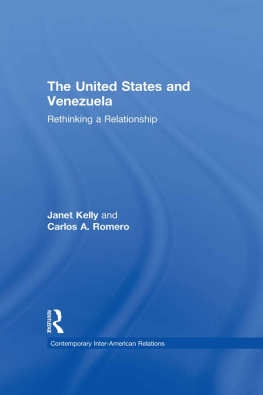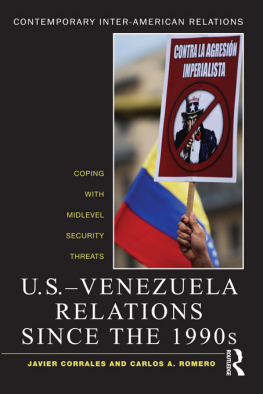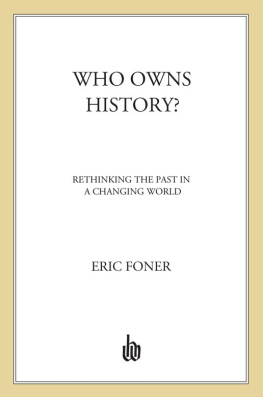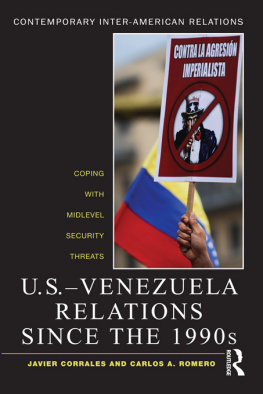The United States and Venezuela
OTHER TITLES IN THE CONTEMPORARY
INTER-AMERICAN RELATIONS SERIES
EDITED BY JORGE DOMNGUEZ AND
RAFAEL FERNNDEZ DE CASTRO
The United States and Mexico:
Between Partnership and Conflict
Jorge Domnguez and Rafael Fernndez de Castro
The United States and Chile:
Coming in from the Cold
David R. Mares and Francisco Rojas Aravena
The United States and Venezuela:
Rethinking a Relationship
Janet Kelly and Carlos A. Romero
The United States and Argentina:
Changing Relations in a Changing World
Deborah Norden and Roberto Russell
CONTEMPORARY INTER-AMERICAN RELATIONS
The United States and Venezuela
RETHINKING A RELATIONSHIP
JANET KELLY AND CARLOS A. ROMERO
Published in 2002 by
Routledge
711 Third Avenue
New York, NY 10017
Published in Great Britain by
Routledge
2 Park Square, Milton Park
Abingdon, Oxon, OX14 4RN
Routledge is an imprint of the Taylor & Francis Group, an informa business
Copyright 2002 by Routledge
All rights reserved. No part of this book may be reprinted or reproduced or utilized in any form or by any electronic, mechanical, or other means, now known or hereafter invented, including photocopying and recording, or in any information storage or retrieval system, without permission in writing from the publisher.
Library of Congress Cataloging-in-Publication Data
Kelly de Escobar, Janet.
The United States and Venezuela: rethinking a relationship / Janet Kelly & Carlos A.
Romero.
p. cm. (Contemporary inter-American relations)
Includes bibliographical references and index.
ISBN 0415581843 (hardcover)ISBN 0415931851 (pbk.)
1. United StatesForeign relationsVenezuela. 2. VenezuelaForeign relationsUnited
State. I. Romero, Carlos A. II. Title. III. Series.
E183.8.V3 K45 2001
327.73087dc21 | 2001019761 |
CONTENTS
THE PAST IS PRELUDE:
HISTORICAL BASES FOR U.S.-VENEZUELAN RELATIONS
GLOBAL CHANGES AND RELATIONS BETWEEN THE
UNITED STATES AND VENEZUELA
Authors carry around many books in their heads, and most of them never get written. This book would not have come about without the energy and imagination of Jorge Domnguez and Rafael Fernndez de Castro, who led the project to write a series of volumes on the bilateral relations between the United States and a group of countries in Latin America and the Caribbean. Recognizing the need for studies that would avoid the charge of bias toward one side or another in bilateral relations, they invited us to join our minds and write a single book about the United States and Venezuela that would incorporate the separate visions that spring from our different backgrounds, languages, and perspectives. We accepted the challenge and now offer the result to our readers in the hope that our effort will contribute to their understanding. Each of us has tried to put ourselves in the shoes of the other, see the same relation from a different standpoint, and analyze U.S.-Venezuelan relations with a sympathetic view to both countries. Our objective is to clarify the present and see into the future, but we base our view on the longer trends of history and the big events of the recent past, in particular the breakdown of the Cold War system and the emergence of new concerns with globalization, international justice, and the growing role of international institutions as the rule-makers at the start of the twenty-first century.
We have benefited greatly from the support of Jorge Domnguez and Rafael Fernndez, and their respective institutions, the Weatherhead Center for International Affairs at Harvard University and the Instituto Tecnolgico Autnomo de Mxico (ITAM). The Ford Foundation gave its vote of confidence to the project and enabled the entire group of authors of this and the nine additional books on other countries and areas to meet together several times over the course of the project to exchange ideas, widen horizons, and help one another to place our ideas in a broader context. We thank our own institutions for the time we devoted to the project, sometimes at the expense of our colleagues and often with their help and stimulus, and hope that our effort meets the expectations of these and many others who helped us along the way.
Janet Kelly
Instituto de Estudios Superiores de Administracin (IESA), Caracas
Carlos A. Romero
Instituto de Estudios Polticos, Universidad Central de Venezuela
May 2001
The transition from authoritarian rule to constitutional government.
The continentwide economic depression of the 1980s and the subsequent shift toward more open market-conforming economies.
The end of the Cold War in Europe.
The transformation of relations with the United States.
Each of these major events and processes was an epochal change in the history of Latin America and the Caribbean. More striking is that all four changes took place within the same relatively short time, though not all four affected each and every country in the same way. They became interconnected, with change on each dimension fostering convergent changes on other dimensions. Thus at the beginning of the new millennium we witnessed an important transformation and intensification in U.S.-Latin American relations.
This book is part of a series of ten books on U.S. relations with Latin American and Caribbean countries. Each of these books is focused on the fourth of these four transformations, namely, the change in U.S. relations with Latin America and the Caribbean. Our premise is that the first three transformations provide pieces of the explanation for the change in U.S. relations with its neighbors in the Americas and for the changes in the foreign policies of Latin American and Caribbean states. Each of the books in the series assesses the impact of the epoch-making changes upon each other.
The process of widest impact was the economic transformation. By the end of 1982, much of North America, Western Europe, and East Asia launched into an economic boom at the very instant when Latin America plunged into an economic depression of great severity that lasted approximately to the end of the decade. As a consequence of such economic collapse, nearly all Latin American governments readjusted their economic strategies. They departed from principal reliance on import-substitution industrialization, opened their economies to international trade and investment, and adopted policies to create more open market-conforming economies. (Even Cuba had changed its economic strategy by the 1990s, making its economy more open to foreign direct investment and trade.)
The regionwide economic changes had direct and immediate impact upon U.S.-Latin American relations. The share of U.S. trade accounted for by Latin America and the Caribbean had declined fairly steadily from the end of World War II to the end of the 1980s. In the 1990s, in contrast, U.S. trade with Latin America grew at a rate significantly faster than the growth of U.S. trade worldwide; Latin America had become the fastest-growing market for U.S. exports. The United States, at long last, did take notice of Latin America. Trade between some Latin American countries also boomed, especially within subregions such as the southern cone of South America, Venezuela and Colombia, the Central American countries, and, to a lesser extent, the Anglophone Caribbean countries. The establishment of formal freer-trade areas facilitated the growth of trade and other economic relations. These included the North American Free Trade Agreement (NAFTA), which grouped Mexico, the United States, and Canada; the Mercosur (southern common market), with Argentina, Brazil, Paraguay, and Uruguay; the Andean Community, whose members were Bolivia, Colombia, Ecuador, Peru, and Venezuela; the Central American Common Market (CACM); and the Caribbean Community (CARICOM). U.S. foreign direct and portfolio investment flowed into Latin America and the Caribbean in large quantities, financing the expansion of tradable economic activities; the speed of portfolio investment transactions, however, also exposed these and other countries to marked financial volatility and recurrent financial panics. The transformation in hemispheric international economic relationsand specifically in U.S. economic relations with the rest of the hemispherewas already far-reaching as the twenty-first century began.












